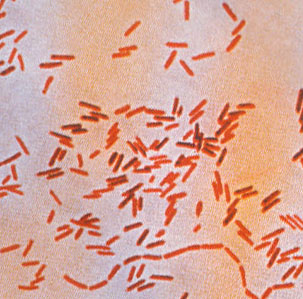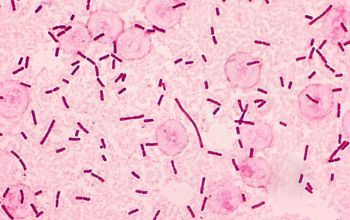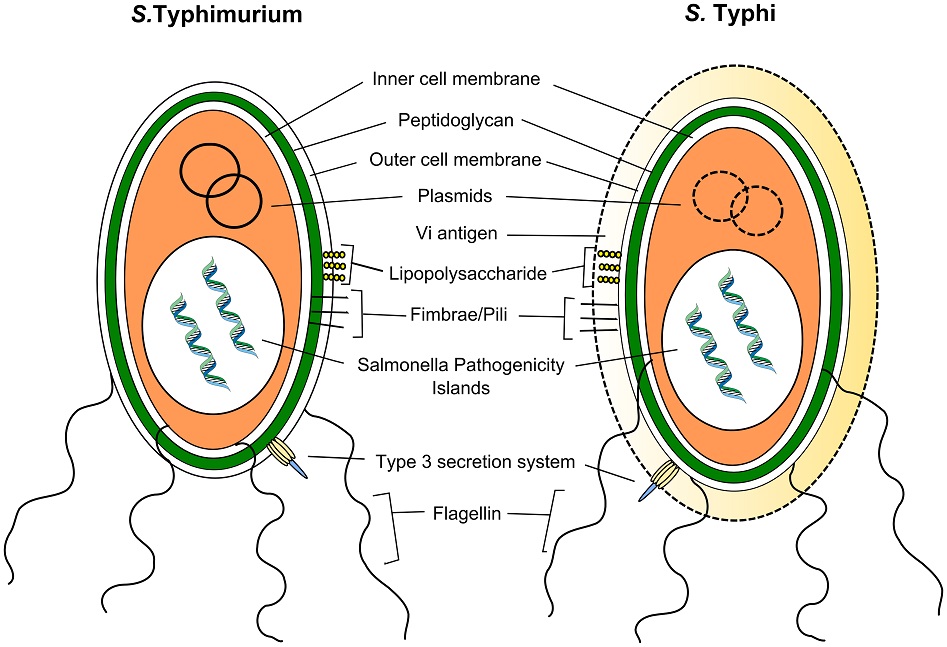Define Enteric Fever and write in details of the Morphology, cultural characters, pathogenesis and Lab Diagnosis of Salmonella Typhi.
Salmonella typhi
Definition
Enteric (intestine) fever or typhoid is a potentially fatal multisystemic illness caused primarily by Salmonella typhi and, to a lesser extent,
S.paratyphi A, B, and C
Morphology of Salmonella typhi
Gram negative bacillus
Rod shaped
Flagella +
2 cell membranes : inner and outer
Facultative aerobic
Salmonella Typhimurium and Salmonella Typhi are two of over 2,500 types of Salmonella enterica.
Salmonella Typhimurium and Salmonella Typhi are closely related. However, there are distinct differences in the type and severity of infectious disease they both cause.
This difference in infections is the result of differences in their genetic makeup.
Epidemiology
Salmonella Typhimurium
Salmonella Typhimurium can cause infections in humans and animals.
Associated with animals and animal products that are eaten.
Transmitted through raw or undercooked infected food including meat and eggs.
Salmonella Typhimurium causes gastroenteritis
People infected by Salmonella Typhimurium may rarely require antibiotics
Salmonella Typhi
Salmonella Typhi can only infect humans.
Causes typhoid fever.
Common in developing countries where hygiene is poor and the water can be contaminated with sewage.
Clinical Features
Typhoidal salmonella - Enteric fever (Typhoid fever)
Non-typhoidal salmonella - Gastroenteritis
Salmonella typhi → Typhoid fever
S.paratyphi A, B, C→ Paratyphoid fever
Fever, weakness, stomach pains, headache or loss of appetite. diarrhoea, vomiting, fever etc.
Without prompt treatment, Salmonella Typhi infection can lead to liver damage, inflammation of the heart, holes in the gut, and internal bleeding.
Bacteremia
Osteomyelitis
Localised infections
Carrier state - excretion of S.typhi in stools or urine for longer than one year after the onset of acute typhoid fever
If appropriate treatment is not given, typhoid fever is fatal in up to 20 per cent of affected individuals.
Diagnosis
Specimens that may be collected
Blood, serum, urint, feces, bone marrow, bile, pus, CSF, sputum, gall bladder, liver, spleen, mesentric lymph nodes
Ideal specimen
First week - Blood for culture
Second week - Serum for antibodies
Third week - Stool
Fourth week - Urine
Blood culture :18 - 15 ml from adults and 2 - 4 ml from children
Inoculate the blood immediately
Transport immediately
Inoculate as soon as possible
Buffy coat from 5 - 10 ml sterile heparinised blood inoculated to Columbia agar plates
Mac Conkey agar can be used
Typhoid is diagnosed by way of a blood or stool sample.
Slide agglutination test - serotyping
Diagnostic sera are added to a slide of cultured bacteria and agglutination is observed proving the diagnosis
Sera available
- Salmonella polyvalent O (Groups A-G) serum
- Salmonella polyvalent H phases 1 and 2 serum and polyvalent H phase 2 serum
- IndividualSalmonella O group sera 02 - O13
- Single factor H sera
Rapid detection tests from culture - MUCAP test
OBIS Salmonella test - Oxoid biochemical identification system - rapid colorimetric spot test.
Clot culture - higher rate of isolation than blood cultures (bactericidal action of the serum is obviated)
Serum testing
Widal Test
Measuremet of H and O agglutinins for typhoid and paratyphoid - principle : tube agglutination
Slide Widal test - undiluted patient serum and antigens
Interpretation
Rising titre - four fold rise in the titre is reliable
Single report - diagnose with caution
Basline titre in endemic areas are O - > 1 : 100; H - > 1 : 200
IDL Tubex test - simple, rapid - slide latex agglutination test - highly specific for s.typhi - only for Typhoid fever, does not give positivity for S.paratyphi - Detects IgM antibodies
the culture (Gold Standard)
IgM dipstick test
Enterocheck - WB test - immunochromatographic test in cassette form
Coagglutination test
Urine : Positive only in second and third weeks = clean voided urine samples are inoculated into enrichment and selective media
Faeces : valuable in patients on antibiotics ( drug does not eliminate the bacilli from the gut). Fecal samples plated directly on Macconkey, DCA/XLD,or Wilson Blair media and cultured
PCR test is sensitive, but not widely used
Typhidot test is found to have highsensitivity and good specificity, and is an alternate to blood culture
Studying the genetics of Salmonella
Studying the genes of Salmonella in different strains helps to know how they cause disease and how they could be treated.
The bacterium’s genome has changed over time to enable it to be resistant to common antibiotics.
Doing this has allowed scientists to identify unique genes found in the individual types.
For example, through DNA sequencing we know that Salmonella Typhimurium has 479 unique genes and Salmonella Typhi has 609 unique genes.
Using next-generation sequencing, scientists are able to identify changes in the DNA of the bacteria and explore more closely their ability to adapt and exploit their host.
This suggests that they are adapting specifically to survive within human hosts.
* * * * * * *







